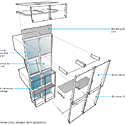Robo Buildings: Pursuing the Interactive Envelope
Omniscient control, or edge monkeys?
Beyond two ways to build a wall, the Morphosis projects also suggest two ways to make walls smart: independent control or centralized control. A project at Cooper Union in New York will integrate all facade operations into the building automation system (BAS), whereas Caltrans has independent (although Internet-accessible) envelope controls and a common override function only for emergencies, such as high winds.
Recent thinking on active envelopes mirrors that for m/e/p design generally: avoid complexity and, therefore, very integrated schemes. Some projects, such as Arup's Plantation Place , have explored highly localized automation. There, sensors mounted on the inner facade detect solar conditions for each tenant zone. Solar blinds in specified areas raise or lower autonomously, depending on the local temperature, sun strike, and occupant preferences. Natural ventilation rates are determined locally as well. Like the robotic edge monkeys, however, such islands of control need occasional global guidance-and the will to ignore the people they serve. "You can't rely on human input," says Arfon Davies, an associate with Arup Lighting in London. "And if automatic shading controls are independent from the BAS, they should still be able to send a signal to the BAS to indicate a fault."
Davies adds that even the most automated systems should have a local override. More important, says LBNL's Lee, "Windows are very much a personal item, and having that control taken away from you can be a pain. You have to have manual override." Taking a related tack, Gould Evans chose to split the control of interior blinds for Biodesign Institute. Above 8 feet from each floor, the shading is fully automated based on solar position; below that, occupants choose. "These systems begin to have a determinist impact on the psychology of the user," says Gould Evans principal Jay Silverberg. Is any optimism warranted for a new wave of smart buildings? "Architectural environments will be increasingly smart and responsive and capable of complex behaviors," predicts Michael Fox, the Venice, California−based architect and robotics expert. "Designing interactive architectural systems is not inventing, but appreciating and marshaling the technology that exists and extrapolating it to suit an architectural vision."
Edge monkeys, indeed.
C.C. Sullivan is a consultant and author who specializes in architecture and technology. He is currently writing a book on interactive building envelopes.











